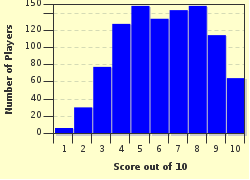Quiz Answer Key and Fun Facts
1. What do you use to work out the formula of an ion?
2. Isotopes of the same element have different numbers of what?
3. What is the apparatus used to separate crude oil into more useful substances called?
4. What is the general formula for an alkene?
5. Why is ice less dense than water?
6. Is sodium a group 1 metal?
7. Electronegativity is defined as?
8. If you had 23 grams of sodium, how many moles would you have?
9. Who is credited with coining the idea of "Triads?"
10. What is the oxidation number of one chromium atom in potassium dichromate, K2Cr2O7?
Source: Author
clarod
This quiz was reviewed by FunTrivia editor
crisw before going online.
Any errors found in FunTrivia content are routinely corrected through our feedback system.


